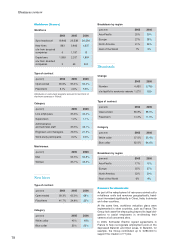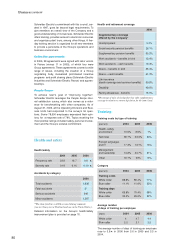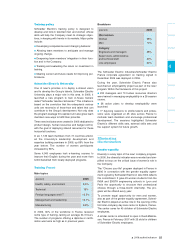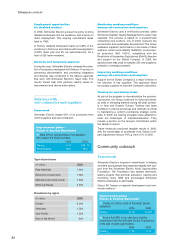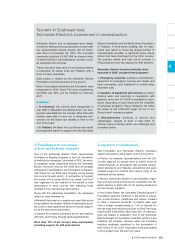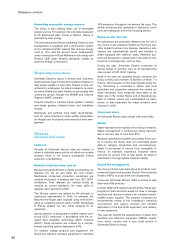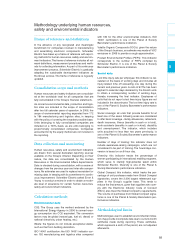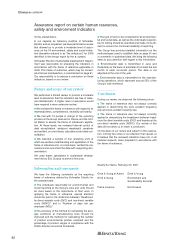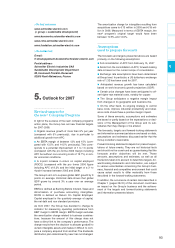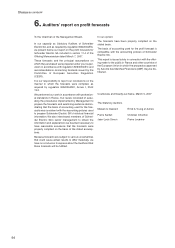APC 2006 Annual Report Download - page 89
Download and view the complete annual report
Please find page 89 of the 2006 APC annual report below. You can navigate through the pages in the report by either clicking on the pages listed below, or by using the keyword search tool below to find specific information within the annual report.
2003 reflects the continuous improvement plans at
each site.
Water and energy consumption data are consolidated
in the table on page 86.
Raw materials
In its ongoing drive to protect the environment, Schnei-
der Electric is making its products more compact to
conserve natural resources and constantly improving
its lineup to make electrical installations more energy
efficient. To facilitate end-of-life processing, it chooses
materials that are easy to recycle and clip-together
systems that are easy to disassemble. Life cycle analy-
ses and recyclability assessments help the Group
identify areas for improvement.
Example:
The latest generation Galaxy uninterruptible power
supplies from MGE UPS Systems are significantly
more efficient than the previous generation (now
around 15 years old). As a result, the energy loss from
this equipment has declined by around 15 toe (1 toe =
11,626 kWh).
Measures to reduce
energy consumption
Energy consumption at production sites
As the marketplace’s energy efficiency partner,
Schneider Electric applies its solutions in its own oper-
ations through the "Energy Action" program to reduce
consumption.
The objective is to reduce energy consumption per
production site employee by 10% by the end of 2008.
The program focuses on five key areas: heating, air
conditioning, equipment (notably for data processing),
lighting and specific manufacturing processes.
As of December 2006, 50 sites had launched action
plans, including 26 in the United States, 5 in the Unit-
ed Kingdom, 18 in France and 1 in India.
In the US, the Oxford, Ohio site reduced its electricity
expenses by 27% and its water bill by 9% with a return
on investment within two to three years.
The five pilot sites in the UK have cut their consump-
tion by 22%.
87
4
European RoHS directive
The European Restriction of Hazardous Sub-
stances (RoHS) directive, which came into effect on
July 1, 2006, bans lead, mercury, cadmium, hexava-
lent chromium and brominated flame retardants in
certain electrical and electronic equipment–primari-
ly household goods–sold in Europe.
The directive affects only a small portion of Schnei-
der Electric’s lineup directly, but it impacts a larger
share indirectly. This is the case for equipment inte-
grated in finished products covered by RoHS.
The Group has gone far beyond the directive's
requirements and decided to stop using these
substances all together.
Step one: July 1, 2006
In line with its commitment, the Group brought all
directly concerned and frequently integrated prod-
ucts into compliance with the directive as of July 1,
2006. Examples include:
> The GV2 contactor, now made using trivalent
chromium instead of hexavalent chromium.
> The C60 circuit breaker, now made without lead,
with trivalent chromium rather than hexavalent
chromium, and with bromine-free materials for the
plastic parts.
As part of this program, Schneider Electric has
worked closely with suppliers to identify substitute
components and materials that meet quality and
performance requirements. In particular, specific
measures were taken to ensure component reliabil-
ity in the area of lead-free electronics.
The Group has also participated actively in the
publication of guides, such as the document pre-
pared by the Fédération des industries électriques,
électroniques et de communication (FIEEC), which
presents a shared vision for the electric industry.
Throughout the transition period, the Group
focused continuously on ensuring product quality
and reliability while complying with customer dead-
lines.
Partners can find all the information they need to
understand the directive, track implementation and
consult the RoHS-compatible catalog at
www.rohs.schneider-electric.com.
The date of RoHS-compliant production is given for
each product.
Step two: end-2008
The Group is currently eliminating the six sub-
stances from its entire low voltage lineup, including
in products not covered by the directive.
In addition, the Group has decided to stop using
cadmium in its products’ electrical contacts, even
though it could obtain a time extension from the EU.
Eliminating hazardous
substances in other countries
Although the RoHS Europe directive only applies to
products sold in Europe, Schneider Electric has
decided to bring its entire lineup into compliance
worldwide before the end of 2008. In this way, it will
be prepared for regulatory changes in other coun-
tries, such as China. Products in China will be com-
pliant long before hazardous substances are effec-
tively banned. New regulations are expected in the
months ahead in India, the United States, South
Korea, Australia and other countries.
2006 audited indicators



